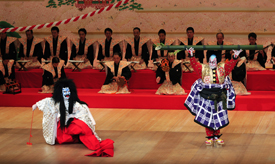Kabuki Plus
Pinnacle of onnagata dance
This exacting piece is considered the pinnacle of onnagata (female-role performer) dance. All the techniques for onnagata are presented during the show. The actor is onstage for nearly the entire piece and must dance solo for almost an hour
Two versions: Otowaya school and Narikomaya school
notable!The dance is performed in two versions. The Otowaya version has been passed down from Kikugoro VI to Baiko VII, Kikugoro VII, Kanzaburo XVIII and Kikunosuke V. The other is the Narikomaya school originated by Utaemon V. Among numerous variations, when the actor removes the headgear, the Otowaya school drops it on the half-opened fan and performs a mie, while Narikomaya actors hang it on the bell rope. In the bouncing ball scene, the former gathers cherry petals to make a ball, whereas the latter pulls a ball from his chest, drawing the monks into the game. There are also differences in the half-opened fan and costume design.
Exorcism

The conclusion of the show has two variations. One finishes with Hanako climbing triumphantly on top of the bell, and the other shows Hanako’s spirit exorcised by a superhero. In the latter, Hanako appears as a demon who reveals her true self as a snake with lavish makeup and long red hair. The scene of the exorcism is included in the Eighteen Select Plays of the Danjuro family. The actor performing the exorcism cuts a striking figure with lavish makeup, high wooden sandals, straw cape and bamboo hat, making his appearance on the hanamichi with a long green stick.
【photo】[from left]Hanako(Nakamura Fukusuke)、Odate Samagoro(Ichikawa Ebizo) August 2010 Shinbashi Enbujo Theatre
From courtesan to young girl
The first Kabuki version of this piece, Keisei (Courtesan) Dojoji (1731), told of the ghost of a courtesan turning into a dance performer to visit the bell dedication ceremony. In the subsequent Momochidori (Hundred Plovers) Musume Dojoji (1744), the courtesan takes over a country girl’s body and performs her lamentation scene with gestures and hand drums. The present dance was created in this wake. The prior works feature a specific woman telling a story of unrequited love, but the dance gradually became a universal story exploring female emotions. This version had wide appeal, with a glamour and lightness of touch that met the taste of Edo audiences. It eventually became the standard.
Derivative works
notable!There are many derivative works from this show. One features a male performer who initially disguises himself as a female dancer. This remains popular as Yakko (Rascal) Dojoji, which took its current shape during the Meiji Period. The lamentation scene famously uses three distinctive masks. There is also Meoto (Male and Female) Dojoji where the actor portrays both a male and female, and Ninin (Two-Person) Dojoji done by two dancing girls.
Legend of Anchin and Princess Kiyo
Dojoji Temple in present-day Wakayama Prefecture is known for an ancient legend. Princess Kiyo, the daughter of a local ruler, falls in love with a monk named Anchin when he stays at her home during a pilgrimage. When she begs him to marry her, the flustered Anchin, intent on remaining true to his religious vows, tells her that he would do so after his pilgrimage, but ultimately leaves with no intention of returning. Having realized that she was duped, the princess goes mad and pursues him in a fury. The panicky Anchin crosses a river and desperately goes for aid to Dojoji, where the monks hide him under a bell. Princess Kiyo turns into a snake to cross the river, slithers into the temple and wraps herself around the bell, melting away both the bell and the monk inside.